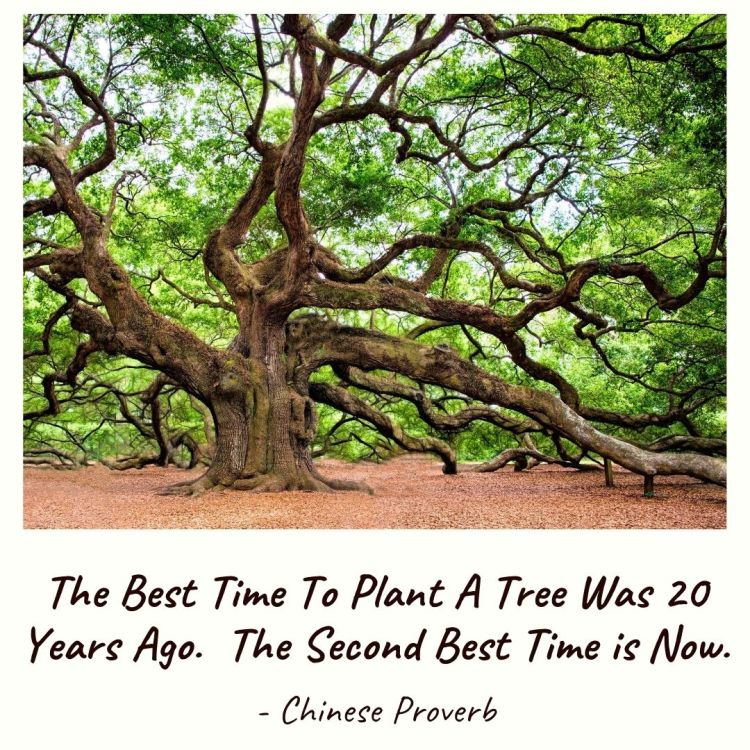Gardening With Trees

Trees Add Value
According to the U.S. Department of Agriculture, “One acre of forest absorbs six tons of carbon dioxide and puts out four tons of oxygen. This is enough to meet the annual needs of 18 people.” They shade your home or business, cutting your summer cooling bill and raising your property value. Trees and shrubs provide food and cover for songbirds and other wild creatures. Cool, green foliage creates a peaceful setting where you can deal with the stresses of daily life. Around your community, trees cleanse and cool the air, buffer wind and noise, protect water quality, prevent soil erosion, screen unsightly areas, and provide a setting for outdoor recreation.
While 20 years ago might have been the best time to plant a tree, the second best time is right now. However, in general, trees tend to be the happiest when planted late fall through early spring. This way, the heat of summer and the tree budding does not stress the root system while it is trying to get established.
Healthy Tree Tips
- Plant the right tree in the right place. Native tree species are usually a good choice because they are adapted to local soil and rainfall conditions. Be careful though; just because a tree is native to Texas, doesn't mean it will work in your yard.
- Properly water. Deep watering is important. Keep the hose handy and water the root zone of your tree twice per week during the growing season, and once per week during winter, for the first two years. Be careful not to drown the roots—they need air as well as water to grow.
- Mulch. Put a 3 or 4 inch layer of bark, leaves, or straw around the tree, keeping it 6”away from the trunk. Mulch helps to keep weeds and grass out, retains moisture, and moderates soil temperature.
- Prune. Before planting, take care to prune off all dead, damaged, or rubbing branches. Also, prune to develop a single primary trunk, and try to remove limbs that grow off of that trunk at a narrow angle (the strongest branches grow at a right-angle from the trunk).
For more tips about trees in the Permian Basin, please download our Tree Guide For The Permian Basin.
Oak Wilt
Oak Wilt is caused by a fungus, Ceratocystis fagacearum, that clogs the water-conducting tissues of infected trees, causing them to wilt and die.
Oak Wilt in Live Oaks can be recognized by the leaf veins turning yellow or brown while the rest of the leaf remains green (see photo below). Leaf drop follows and trees die in two to four months. In Red Oaks, leaves will wilt or suddenly turn brown and hang on the tree. Infected trees generally die in two weeks.
The disease primarily affects Red Oak species, including Spanish, Texas, Shumard, Pin, and Blackjack. They typically die within 2-4 weeks of symptom appearance. White oaks are the least susceptible. Very few have been identified with oak wilt in Texas. They generally survive for a number of years with the disease. Common White Oak species includes Post, Bur, Chinkapin, and Monterrey.
This serious disease has killed more than one million trees in central Texas. Unfortunately, Midland County is one of only six west Texas counties with confirmed cases of Oak Wilt, according to the Texas A&M Forest Service.
Oak Wilt - The Spread
Oak wilt spreads long distances with the aid of sap-feeding (Nitidulid) beetles. These beetles are about the size of the ball on the end of a straight pin.
They are attracted to the fruity-smelling fungal mats that form underneath the bark of diseased oaks. The fungal mats produce spores and have a ridge down the center that lifts the bark creating a tiny crack.
Once established, the fungus moves from one tree to the next through common or grafted roots.
Because live oaks tend to grow from root spouts and can form root grafts very readily, all of the live oaks within a given area share a common root system. The pathogen can spread through this system at an average rate of 75 feet per year.
Oak Wilt - Prevention & Treatment
Prevention includes:
- Prune only during the coldest time of the year. During these times, the activity of the disease-carrying beetle is at its lowest level.
- Immediately paint all wounds, including pruning cuts, on oaks to prevent contact with contaminated beetles. Avoid wounding of oaks between the period of Feb. 1 – June 1.
- Sterilize or sanitize all pruning equipment between trees.
- Covering oak firewood with clear plastic sheeting and sealing the loose edges.
- Do not transport or buy unseasoned firewood.
- Promptly remove and either burn or bury all oaks that are dying or have been recently killed by oak wilt.
Treatment includes:
- Stopping the spread through the roots by one of the most common techniques of severing the roots by trenching at least 4 feet deep.
- NOTE: There is a delay between the colonization of the root system by the fungus and the appearance of symptoms in the crown. All trees with symptoms should be carefully identified first.
- Fungicide treatment by using propiconazole (Alamo) can be used as a preventative to reduce oak wilt symptoms in live oaks when applied before infection. Limited success may also be achieved in trees with therapeutic injections during the earliest stages of infection.
- NOTE: Fungicide injection does not stop the root transmission of the fungus. This treatment is used best in conjunction with trenching or to protect individual high-value trees in situations where trenching is impractical.
